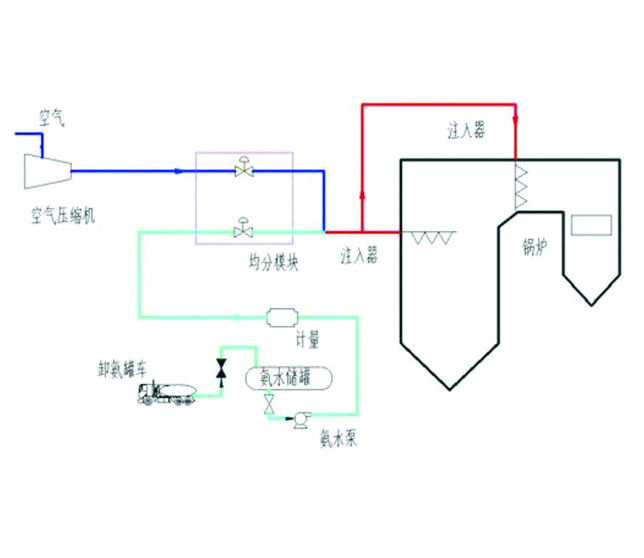
◇System Overview
Selective non-catalytic reduction (SNCR) system is a post-combustion flue gas denitrification technology that removes NOx through a chemical reaction process in which an appropriate amount of reductant is sprayed at the appropriate location in a thermal power boiler, waste combustion furnace, cement kiln or other industrial boiler.
◇Principle of the process
SNCR denitrification systems generally use 20% concentration of ammonia or 50% concentration of urea as the reducing agent, which is transported in tank trucks and stored in liquid form in tanks. The urea needs to be dissolved and diluted, as well as supplied with heat tracing to prevent it from crystallising. The reductant is distributed to each lance by means of a metering and distribution module
and is sprayed by the lance into the furnace for a selective reaction with NOx without catalyst, so that the reductant has to be added in the high temperature zone. The reductant is sprayed into the furnace chamber at a temperature of 800 to 1250°C. The reductant is rapidly and thermally decomposed into NH3 and reacts with the NOx in the flue gas in an SNCR reaction to produce N2, using the furnace chamber as the reactor.
Above: SNCR denitrification system process flow diagram
The above figure is a typical SNCR denitrification system process system flow diagram, which mainly includes the following systems:
■ Reductant preparation and storage system ■ Metering system ■ Distribution system ■ Reductant injection system ■ Electrical, instrumentation and control system
◇ Chemical reaction
■Ammonia radical reacts with NOx, and oxygen in the flue gas participates in the reaction, which is exothermic, but not enough to make up for the exothermic reaction between CO and
O2;
4NO+4NH3+O2→4N2+6H₂O because of the exothermic reaction, and therefore the effect on heat consumption is not obvious
■ but when the reaction temperature is too high, a reverse reaction occurs to produce NO; 4NH3+5O2→4NO+6H₂O
■ SNCR is the reduction of NOx to N2 and H₂O by spraying a reductant into a suitable zone without the presence of a catalyst, when the temperature of the zone is (870-1090°C); the
■ Nitrogen reduction efficiency of 20-70% at NH₃/NOx molar ratios of 0.8-3. If the nitrogen reduction efficiency reaches 85%, then the ammonia/nitrogen molar ratio exceeds 3, the ammonia escape rate is too high and the cost increases too much.
The escaped ammonia is basically absorbed by raw material, and very little ammonia can escape into the atmosphere.
◇ Product Features
1. Simple system, small footprint;
2. Low investment cost and low running cost;
3. Suitable for boilers of various fuels;
4. Fully automatic and efficient control, automatically tracking the optimum temperature range;
5. Modular supply system, making the system simple to install, operate and maintain;
6. Wide range of applications, suitable for use with new production lines and the renovation of old production lines;
7. The denitrification efficiency is 30%~70%, combined with low-NOx burner, the denitrification efficiency can reach more than 80%.
◇ SCR denitrification equipment
